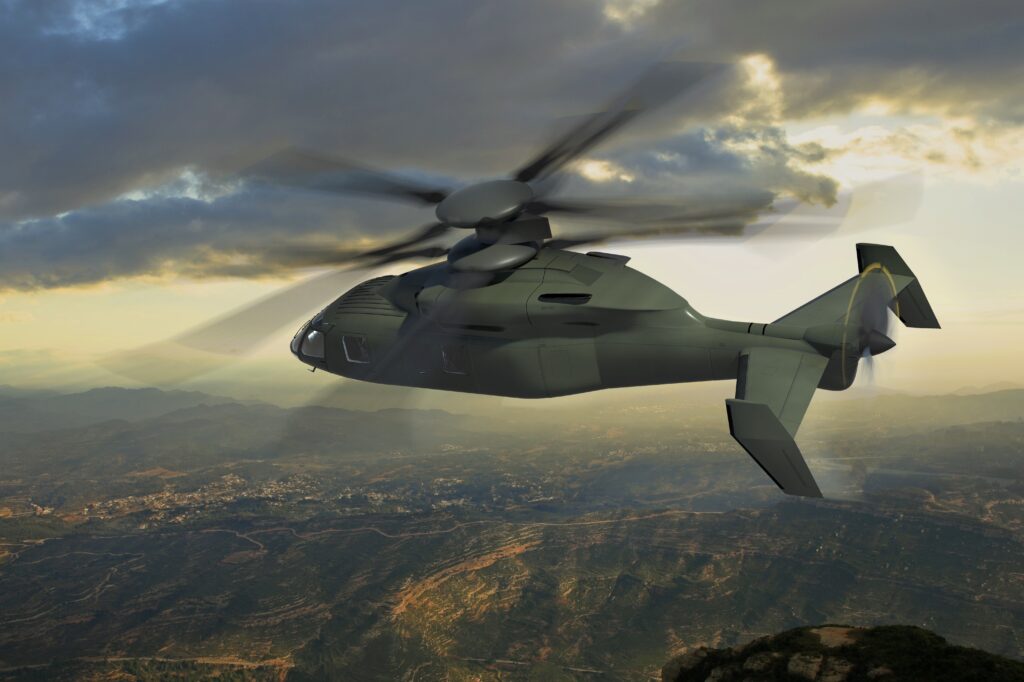
ARLINGTON: And then there were five. There were already going to be four different aircraft in the Future Vertical Lift (FVL) family, from light to medium to heavy to “ultra.”
Now it’s almost certain that the medium FVL will be split into two separate versions: a smaller attack/reconnaissance aircraft and a larger troop-carrying assault craft. What’s more, the Army’s aviation chief said today, they might even end up using entirely different forms of propulsion, for example with one being a tiltrotor (like the V-22 Osprey) and the other being a “compound” helicopter with a pusher propeller and coaxial blades (like the Sikorsky X-2).
“Really, the medium category is going to be two aircraft with two capability sets,” Maj. Gen. Michael Lundy, commanding general of the Aviation Center of Excellence at Fort Rucker told an Association of the United States Army aviation symposium. The logic of splitting the medium lift category into different aircraft will be discussed Friday at a meeting of an FVL executive steering group that includes officers from all the armed services, Lundy added.
“We’re going to talk about where we’re heading,” Lundy said, emphasizing that no decisions are being made at this stage: Much will depend on the results of flight tests in 2017 and 2018 of technology demonstrator aircraft being developed by Bell Helicopter Textron Inc. — the tiltrotor — and a team of Boeing Company and Sikorsky Aircraft Corp. — the coaxial rotors — under the Joint Multirole (JMR) program. An industry official, however, said the Army briefed Bell and the Boeing/Sikorsky team earlier this week on the fact that service leaders think the attack and assault versions of the medium-lift FVL will need to be two different aircraft.
The JMR is one of the first concrete steps in the long-range FVL initiative, which aims to develop new, far faster and more agile vertical takeoff and landing (VTOL) aircraft for all the services in four different sizes: light, medium, heavy and ultra.
The initial requirements for the JMR Technology Demonstrator (JMR-TD) call for attack and utility versions of an aircraft that weighs about 30,000 pounds at takeoff, can fly faster than 230 knots (about 265 miles per hour), can carry as many as 12 troops about 230 miles in the utility version and then loiter for half an hour before returning to base without refueling.
Bell, which builds the V-22 Osprey tiltrotor troop transport for the Marine Corps and Air Force in partnership with Boeing, is offering a new, smaller tiltrotor called the V-280 Valor. Sikorsky and Boeing are developing a compound helicopter with a coaxial rotor and a pusher propeller to provide more speed than a conventional helicopter can manage. Their aircraft, the SB>1 Defiant, is based on Sikorsky’s X2 high speed technology demonstrator and a derivative S-97 the company developed for an armed aerial scout helicopter program the Army has put on hold because budget cuts.
“We’re not going to release a requirements document tomorrow,” Lundy told the AUSA symposium, referring to more specific requirements each service will help develop. “We need to see how mature the technology is and what’s in the realm of the possible. We’re not going to develop ‘unobtainium.’”
In a quick interview with BreakingDefense.com after his remarks, Lundy said that while no decisions are being made yet, it’s clear that the attack aircraft and the assault aircraft need to be sized differently, just as the Army’s current AH-64 Apache attack helicopters and its UH-60 Black Hawk troop carriers are. Other services may also need their own FVL medium variants, he ventured.
“We’re probably not going to have one aircraft that’s going to be able to do all the missions in the medium category,” Lundy said. “I’ve got an attack variant and I’ve got an assault variant. Based on what I see out of JMR-TD, one airplane may not be able to do those, and we’re not going to build a sub-optimized aircraft. If we’ve got to have two different aircraft, we’re going to have two different aircraft.”
FVL is a joint program aiming at producing common aircraft for all the services, as was mandated for the F-35 Joint Strike Fighter, to provide savings through using common parts and equipment.
“Commonality’s going to be in the cockpit, it’s going to be in the drive trains, things like that,” Lundy said, offering the analogy of the AH-1 Cobra attack helicopter and the UH-1 Huey utility helicopter, both made by Bell with many common parts. “They’re differently configured but have a lot of commonality,” Lundy said. “That’s really where we’re going.”
At the same time, he added, “I need to see where JMR-TD goes. It might be that one technology is really good for a smaller aircraft and another technology is better for a larger aircraft. We can’t shrink the size of troops, so we’re going to move a squad inside of the assault variant, so it’s got to be able to move 11 soldiers.” What’s more, he said, “The attack/recon aircraft does not need to be as big as the assault aircraft. The bigger they are the more expensive they are. The bigger they are, the less stealthy they are. But you can only make a squad so small. So we know that the assault aircraft is going to be sized by that. The attack aircraft is sized by speed, range and the payload of the weapons systems.”
